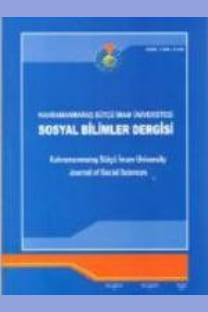Measuring Risk Tolerance in Finance: Does the Decision Frame Matter?
Risk Kabullenme Düzeyi, Risk Düzeyinin Ölçümü ve Riske Bakış Açısı.
Finansal Risk Kabullenme Düzeylerinin Ölçümü: Karar Süreçlerinin Etkisi?
Risk Tolerance, Risk Measurement and Risk Attitudes.,
___
- Arrow, Keneth (1971), Essays in the Theory of Risk-Bearing, North-Holland Publishing Co., Amsterdam.
- Becker, Gordon – Degroot - Moris - Marschak, Jacob (1963), “Probabilities of Choices among very Similar Objects: An Experiment to Decide Between Two Models”, Behavioral Science, Vol. 8, No 4, pp.306–311. Bontempo, Robert - Bottom, William - Weber Elke (1997), “Cross ‐Cultural Differences in Risk Perception: A Model Based Approach”, Risk Analysis, Vol. 17, No: 4, pp.479–488.
- Booij, Adam and Praag, Bernard (2009), “A Simultaneous Approach to the Estimation of Risk Aversion and the Subjective Time Discount Rate”, Journal of Economic Behavior and Organization, Vol. 70, No: 1-2, pp.374–388.
- Brooks, Robert - Faff, Robert - Mulino, Daniel - Scheelings, Richard (2008), “Deal or No Deal, that is the Question: The Impact of Increasing Stakes and Framing Effects on Decision-Making under Risk”, Working Paper, available at http://ssrn.com/abstract=1089981.
- Daghofer, Fedor (2007), “Financial Risk-Taking on ‘‘Who Wants to Be a Millionaire’’: A Comparison between Austria, Germany, and Slovenia”, International Journal of Psychology, Vol. 42, No: 5, pp.317–330.
- Dohmen, Thomas - Falk, Armin – Huffman, David - Sunde, Uwe - Schupp, Jurgen - Wagner Gert (2005), “Individual Risk Attitudes: New Evidence from a Large, Representative, Experimentally-Validated Survey”, IZA Discussion Paper, No. 1730, available at http:// www.iza.org/en/webcontent/publications/papers/viewAbstract?dp_id=1 7
- Donkers, Bas – Melenberg, Bertrand - Van Soest, Arthur (2001), “Estimating Risk Attitudes Using Lotteries: A Large Sample Approach”, The Journal of Risk and Uncertainty, Vol. 22, No: 2, pp.165–195.
- Douglas, Mary and Wildavsky, Aaron (1982), Risk and Culture: An Essay on the Selection of Technical and Environmental Dangers. Berkeley: University of California Press.
- Eisenhauer, Joseph (2003), “Approximation Bias in Estimating Risk Aversion”, Economics Bulletin, Vol. 4, No: 38, pp.1−10.
- Grable, John (2000). “Financial Risk Tolerance and Additional Factors that Affect Risk Taking in Everyday Money Matters”, Journal of Business and Psychology, Vol. 14, No: 4, pp.625–630.
- Grable, John and Lytton Ruth (1998), “Investor Risk Tolerance: Testing the Efficacy of Demographics as Differentiating and Classifying Factors”, Financial Counseling and Planning, Vol. 9, No: 1, pp.328–339.
- Grable John and Lytton Ruth (1999), “Financial Risk Tolerance Revisited: The Development of a Risk Assessment Instrument”, Financial Services Review, Vol. 8, pp.163–181.
- Hallahan, Terrence - Faff, Robert - Mckenzie Michael (2003), “An exploratory Investigation of the Relation between Risk Tolerance Scores and Demographic Characteristics”, Journal of Multinational Financial Management, Vol. 13, pp.483–502.
- Harrison, Glenn - Lau, Morten - Ruström, Elisabet. (2007), “Estimating Risk Attitudes in Denmark: A Field Experiment”, Scandinavian Journal of Economics, Vol. 109, No: 2, pp.341–368.
- Holt, Charles and Laury Susan (2002), “Risk Aversion and Incentive Effects”, American Economic Review, Vol. 92, No: 5, pp.1644–1655.
- Kahneman, Daniel and Tversky, Amos (1979), “Prospect theory: An Analysis of Decision under Risk”, Econometrica, Vol. 47: 263–291.
- ISSN: 1304-8120
- Yayın Aralığı: 3
- Başlangıç: 2004
- Yayıncı: Kahramanmaraş Sütçü İmam Universitesi
Measuring Risk Tolerance in Finance: Does the Decision Frame Matter?
Unorthodox monetary poliy of Turkey after the global financial crisis
Kahramanmaraş’ın Tarihi Coğrafyasına Bir Bakış
Unorthodox Monetary Policy Of Turkey After The Global Financial Crisis
Ersin Kaya SANDAL, - NadireKARADEMİR
Yükseköğretimde Değişim: Kalite Arayışları
Didem TEZSÜRÜCÜ, Sibel AYBARÇ BURSALIOĞLU
Bir Ekonomik Suç: Ödeme Tahhüdünü İhlal ve Tazyik Hapsi
Rusya’da Osmanlı Tarihi Araştırmaları ve Rusça Yayımlanmış Türkiye Bibliyografyaları
Sosyal Bilgiler Dersinde Karakter Eğitimi
